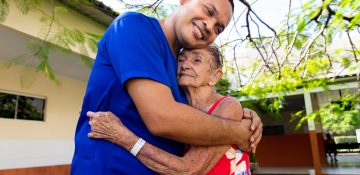Blog: Improving Quality of Life for Persons Affected by Leprosy

Leprosy is a chronic infectious disease that mainly affects the skin, nerves, upper respiratory tract, and eyes. According to the WHO, there were 140,594 new cases of leprosy detected globally in 2021. This is surprising, considering treatments such as multidrug therapy have been found largely effective in curing the illness. But leprosy is rampant primarily in resource-limited countries, especially in crowded environments. And the same persons affected by leprosy are the ones who have limited access to the medical attention they need.
In his book ‘Being Mortal’, American surgeon and public health researcher Atul Gawande asserts that medicine and care — no matter how it is delivered — can go a long way in helping make life easier for leprosy patients. So considering how leprosy influences a person’s physiological, psychological, social, and economic well-being, no effort should be spared in trying to improve the quality of life of those affected by leprosy. Here are some ways this can be achieved.
Destigmatization efforts
The social stigma surrounding leprosy can seriously limit an individual’s participation in social and professional contexts, resulting in minimal opportunities. It can also decrease one’s opportunities to receive adequate treatment and support.
In ‘Carville – Remembering Leprosy in America’, author Marcia Gaudet emphasizes that beyond being a scientific battle, scientists, physicians, and policymakers should recognize the human experiences behind leprosy. When addressing leprosy, it’s crucial to combat the stigma surrounding it, to ensure that human rights are respected. Rather than ending in treatment, individuals must also be provided with social support and rehabilitation. The WHO also suggests the adoption of principles and guidelines to eliminate discrimination. Furthermore, organizations should seek to spread awareness about how leprosy works and the importance of seeking and providing medical care.
Comprehensive treatment plans
When untreated, long-term leprosy can result in chronic pain associated with nerve damage, leprosy reactions, and neuritis. The Biopsychosocial Model of Chronic Pain asserts that in addition to this, psychological and social factors also interact to influence the experience of pain.
Considering that the experience of leprosy is a dynamic interaction of these three dimensions, the treatment of persons affected by leprosy must be diversified. This means that the treatment of leprosy must be individualized to address the specific physiological factors a patient experiences and the environmental circumstances they find themselves in.
Digital interventions
Governments, policymakers, and other stakeholders are making leprosy response scalable and sustainable by adopting digital health solutions. Such solutions can be integrated into national health systems. A study published in the journal Infectious Diseases of Poverty states that digital interventions can include eLearning, digital diagnostics, and the geolocation of individuals affected by leprosy.
Other applications, such as digital registries, leprosy referral and surveillance networks, and other telehealth initiatives are also in development. By adjusting policies to support the widespread implementation of these digital interventions, technology can make healthcare more accessible for persons affected by leprosy, especially in underserved areas.
Early diagnosis
The early diagnosis of leprosy can prevent chronic complications. But our blog post ‘Why Global Dermatological Care Should Not Be Overlooked’ explains that skin diseases are often overlooked or not recognized in time by health professionals with limited dermatological training.
Community leaders, health workers, and volunteers must collaborate to aid communities in early detection. Skin camps are health events that screen community members for skin diseases like leprosy and more common ones like eczema and acne. By grouping all these conditions, those with skin diseases may be less reluctant to participate.
Although easily curable, many systemic impediments bar persons affected by leprosy from receiving the medical and social support that they need. With these approaches in place, these individuals can be met with the resources they need to see an improvement in their quality of life.
Voluntarily written for nlrinternational.org by Alicia Cassandra Clark. Opinions stated in the article are on personal title of the author and do not necessarily express NLR’s views.